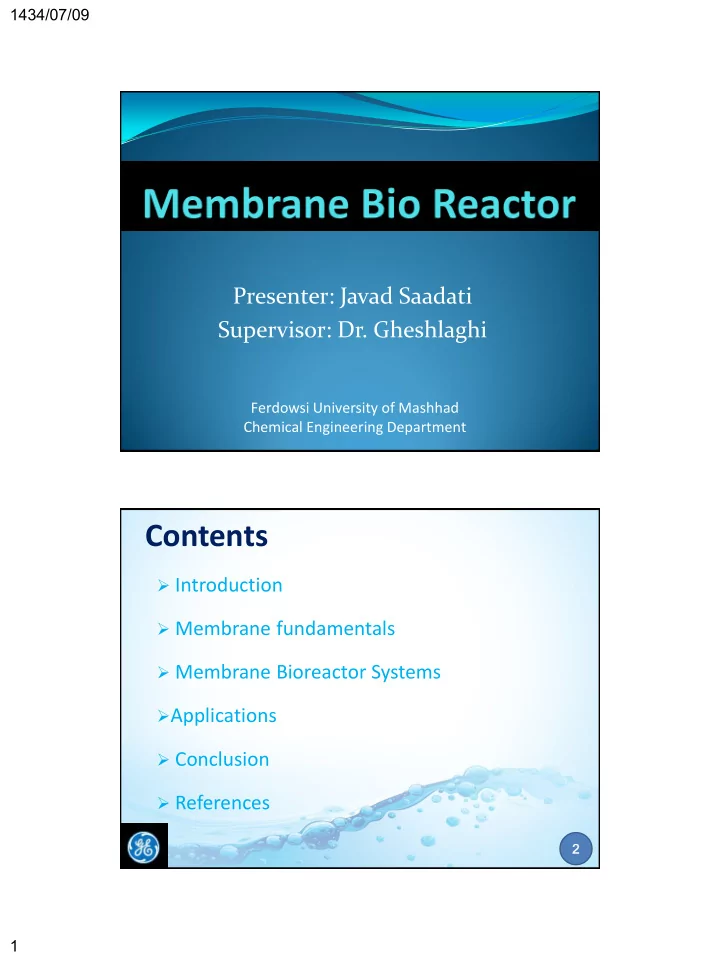

1434/07/09 Presenter: Javad Saadati Supervisor: Dr. Gheshlaghi Ferdowsi University of Mashhad Chemical Engineering Department Contents Introduction Membrane fundamentals Membrane Bioreactor Systems Applications Conclusion References 2 1
1434/07/09 Introduction A membrane is defined as a material that forms a thin wall capable of selectively resisting the transfer of different constituents of a fluid and thus effecting a separation, of the constituents [1]. For many processes the membrane acts in a way to reject the pollutants, which may be suspended or dissolved and allow the “purified” water through it. 3 Membrane fundamentals Membranes can be classified by [1]: 1) the driving force used for the separation of impurities, such as pressure, temperature, concentration gradient, partial pressure, electrical potential etc; 2) the structure and chemical composition, 3) the mechanism of separation and 4) the construction geometry of the membrane. 4 2
1434/07/09 Membrane fundamentals There are six commercially used membrane separation processes [2]: Microfiltration (MF) Ultrafiltration (UF) Nanofiltration (NF) Reverse Osmosis (RO) Dialysis Electrodialysis (ED) 5 Membrane fundamentals o Microfiltration (MF) and ultrafiltration (UF) are low pressure driven processes. o Reverse osmosis (RO) is a high pressure driven process designed to remove salts and low molecular organic and inorganic pollutants. o Nanofiltration (NF) operates at a pressure range in between RO & UF targeting removal of divalent ion impurities [1]. 6 3
1434/07/09 Membrane fundamentals 7 Membrane fundamentals Membrane Materials: Organic polymer Ceramic * All of commercial MBR manufacturers use polymeric MF membranes. 8 4
1434/07/09 Membrane fundamentals Polymer Membranes: Low cost production Natural variations in pore size Prone to fouling and degradation Ceramic Membranes: Excellent quality and durability Economically unfeasible for large operations 9 Membrane fundamentals The most common types of MBR are hollow fiber and plate and frame. Hollow fiber membranes are extruded into long fibers and joined into bundles, called modules. The modules are submerged in the wastewater and permeate is drawn into center of the fiber by an applied vacuum. 10 10 5
1434/07/09 Membrane fundamentals Plate and frame modules are made from large membrane sheets loaded into cassettes. Permeate is drawn through the membrane due to an applied pressure differential. 11 11 Membrane Bioreactor Systems Membrane Bioreactor (MBR) systems essentially consists of combination of membrane and biological reactor systems. These systems are the emerging technologies, currently developed for a variety of advanced wastewater treatment processes. 12 12 6
1434/07/09 Membrane Bioreactor Systems In general, MBR applications for wastewater treatment can be classified into four groups, namely: Extractive Membrane Reactors I. Bubble-less Aeration Membrane Bioreactors II. III. Recycle Membrane Reactors IV. Membrane Separation Reactors 13 13 Membrane Bioreactor Systems Extractive Membrane Reactors Extractive membrane bioreactors (EMBR) enhance the performance capabilities of biological treatment of wastewater by exploiting the membrane’s ability to achieve a high degree of separation. This separation aids in maintaining optimal conditions within the bioreactor for the biological degradation of wastewater pollutants. 14 14 7
1434/07/09 Membrane Bioreactor Systems Extractive Membrane Reactors 15 15 Membrane Bioreactor Systems Extractive Membrane Reactors 16 16 8
1434/07/09 Membrane Bioreactor Systems Bubble-less Aeration Membrane Bioreactors In a conventional aerobic wastewater treatment unit such as an activated sludge process, the process efficiency is controlled by the availability of air. Due to inefficient mode of air supply, 80-90% of the oxygen diffused as air in an activated sludge process is vented to the atmosphere. 17 17 Membrane Bioreactor Systems Bubble-less Aeration Membrane Bioreactors The membrane aeration bioreactor (MABR) process use gas permeable membranes to directly supply high purity oxygen without bubble formation to a biofilm. As the gas is practically diffuse through the membrane, very high air transfer rate is attained. The membrane also acts as a support medium for the biofilm formation, which reduces the potential for bubble formation and air transfer rate. 18 18 9
1434/07/09 Membrane Bioreactor Systems Recycle Membrane Bioreactors The membrane recycle bioreactor consists of a reaction vessel operated as a stirred tank reactor and an externally attached membrane module. The substrate (feed wastewater) and biocatalyst are added to the reaction vessel in pre-determined concentrations. Thereafter the mixture is continuously pumped through the external membrane circuit. 19 19 Membrane Bioreactor Systems Recycle Membrane Bioreactors The smaller molecular compounds, the end products of the biodegradation reaction, are permeated through the membrane. While the large molecular size biocatalyst are rejected and recycled back into the reaction tank. 20 20 10
1434/07/09 Membrane Bioreactor Systems Membrane Separation Bioreactors Application of membrane separation (micro or ultra filtration) techniques for biosolid separation in a conventional activated sludge process can overcome the disadvantages of the sedimentation and biological treatment steps. The membrane offers a complete barrier to suspended solids and yields higher quality effluent. In this system, the solid-liquid membrane separation bioreactor employs filtration modules as effective barriers. 21 21 Applications MBR treatment is applicable to many sectors, including: Municipal Industrial Water reclamation 22 22 11
1434/07/09 Conclusion The application of MBR technology is rapidly expanding, with new installation occurring every year. MBR technology is highly suited for the reclamation of waste water due to the ability to produce drinking water quality effluent. The small foot print and ease of operation of the MBR system makes it ideal for application in remote areas where waste water can be reused for irr 23 23 References [1] C. Visvanathan, R. Ben Aim. Membrane Bioreactor Applications in Wastewater Treatment [2] Stacy Scott, Application of membrane bioreactor technology to waste water treatment and reuse. [3] Neha Gupta, N Jana, submerged membrane bioreactor system for municipal waste water treatment process: an overview, Indian journal of chemical technology, Vol. 15, pp. 604- 612. 24 24 12
Recommend
More recommend